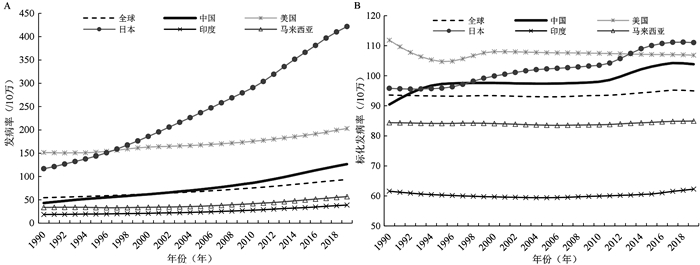Analysis on the status and trend of dementia burden in China based on the global perspective
-
摘要:
目的 分析1990-2019年中国痴呆症的疾病负担现状、变化趋势及危险因素,为痴呆症的防控提供科学依据。 方法 基于2019年全球疾病负担(Global Burden of Disease, GBD)数据,获取1990-2019年中国、美国、日本、印度、马来西亚和全球痴呆症发病率、死亡率、伤残调整寿命年(disability adjusted life year, DALY)率及相应标化指标,利用Joinpoint软件计算痴呆症标化发病率、死亡率的年度变化百分比(annual percent change, APC)和平均年度变化百分比(average annual percent change, AAPC),分析痴呆症发病和死亡随年份变化的趋势。 结果 2019年中国痴呆症的疾病负担均表现为女性高于男性,高年龄组高于低年龄组。中国痴呆症的发病率、死亡率和DALY率分别从1990年的43.32/10万、7.88/10万、155.95/10万上升至2019年的126.57/10万、22.55/10万、420.22/10万。2019年中国痴呆症标化发病率、标化死亡率及标化DALY率均高于全球,但低于日本。中国痴呆症标化发病率平均每年上升0.47%、标化死亡率无明显变化。2019年造成男性和女性痴呆症疾病负担的主要危险因素分别为吸烟、高BMI和高FPG。 结论 1990年以来,中国的痴呆症疾病负担总体呈上升趋势,应继续加强痴呆症防控的宣传教育,尤其关注老年人群的预防控制,制定合理政策,控制危险因素,进一步减轻中国痴呆症疾病负担。 Abstract:Objective Analyzing the disease burden and its changing trend of dementia in China from 1990 to 2019 to provide a scientific basis for the prevention and control of dementia. Methods Based on the Global Burden of Disease (GBD) 2019 data, to obtain the incidence, mortality and disability adjusted life year (DALY) rates and corresponding standardized indexes of dementia in China, USA, Japan, India, Malaysia, and the global in 1990-2019. Using Joinpoint to calculate annual percent change (APC) and average annual percent change (AAPC) of standardized incidence and mortality rate of dementia and compare the characteristics and trends of the burden of dementia with the development of years. Results In 2019, the incidence, mortality and DALY rate of dementia in China were higher in females than in males and higher in senior age groups than in lower age groups. From 1990 to 2019, the incidence, mortality and disability adjusted life year rate of dementia in China increased from 43.32/100 000, 7.88/100 000, 155.95/100 000 in 1990 to 126.57/100 000, 22.55/100 000, 420.22/100 000 in 2019, respectively. In 2019, the standardized incidence, standardized mortality and standardized DALY rate were higher than those in the global but lower than those in Japan. The standardized incidence rate of dementia in China has increased by 0.47% per year, and the standardized mortality rate has not changed significantly. The main risk factors of dementia in men and women were smoking, high BMI and high fasting plasma glucose in 2019. Conclusions Since 1990, the burden of dementia in China has been on the rise. Health education should be conducted to improve the public knowledge about the prevention of dementia, especially paying attention to the prevention and control of the elderly. People should formulate reasonable policies and control risk factors to further reduce the burden of dementia in China. -
Key words:
- Dementia /
- Incidence /
- Mortality /
- DALY /
- Risk factors
-
表 1 1990-2019年全球、中国、美国、日本、印度和马来西亚痴呆症标化发病率(%)的Joinpoint分析
Table 1. Joinpoint analysis of standardized incidence rates of dementia in global, China, the US, Japan, India and Malaysia from 1990 to 2019
国家/地区 年度变化 AAPC(95% CI)值 t值 P值 年份(年) APC(95% CI)值 t值 P值 中国 1990-1994 1.78(1.64~1.92) 26.79 < 0.001 0.47(0.44~0.51) 27.08 < 0.001 1994-2010 0.03(0.01~0.04) 2.96 0.008 2010-2016 1.06(0.97~1.16) 23.44 < 0.001 2016-2019 -0.04(-0.26~0.17) -0.41 0.683 美国 1990-1992 -1.90(-2.04~1.76) -27.86 < 0.001 -0.16(-0.17~-0.14) -17.29 < 0.001 1992-1995 -1.02(-1.15~-0.88) -15.23 < 0.001 1995-2000 0.71(0.67~0.74) 38.15 < 0.001 2000-2019 -0.06(-0.06~0.06) -40.58 < 0.001 日本 1990-1995 0.01(-0.42~0.43) 0.03 0.980 0.57(0.44~0.70) 8.62 < 0.001 1995-2002 0.83(0.52~1.14) 5.55 < 0.001 2002-2009 0.26(-0.05~0.56) 1.78 0.090 2009-2019 0.88(0.74~1.03) 12.96 < 0.001 印度 1990-1995 -0.45(-0.48~-0.41) -25.99 < 0.001 0.04(0.03~0.05) 7.85 < 0.001 1995-2005 -0.14(-0.16~-0.13) -20.93 < 0.001 2005-2015 0.22(0.20~0.23) 31.89 < 0.001 2009-2019 0.69(0.64~0.74) 28.47 < 0.001 马来西亚 1990-2000 -0.02(-0.04~-0.01) -2.83 0.011 0.03(0.01~0.05) 3.24 0.001 2000-2006 -0.13(-0.18~-0.08) -5.63 < 0.001 2006-2010 0.07(-0.03~0.18) 1.46 0.161 2010-2019 0.18(0.16~0.20) 18.28 < 0.001 全球 1990-2006 -0.03(-0.04~-0.02) -6.18 < 0.001 0.06(0.03~0.08) 4.36 < 0.001 2006-2011 0.10(0.02~0.18) 2.51 0.021 2011-2018 0.30(0.24~0.36) 10.61 < 0.001 2017-2019 -0.09(-0.36~0.18) -0.72 0.479 -
[1] James BD, Bennett DA. Causes and Patterns of Dementia: an update in the era of redefining Alzheimer's disease[J]. Annu Rev Public Health, 2019, 40: 65-84. DOI: 10.1146/annurev-publhealth-040218-043758. [2] World Health Organization. Global Health Estimates 2021[R]. Geneva, 2019, 1-134. [3] Christina P. World Alzheimer report 2018[R]. Alzheimer's Disease International, 2018: 1-48. [4] GBD 2019 Diseases and Injuries Collaborators. Global burden of 369 diseases and injuries in 204 countries and territories, 1990-2019: a systematic analysis for the Global Burden of Disease Study 2019[J]. Lancet, 2020, 396(10258): 1204-1222. DOI: 10.1016/S0140-6736(20)30925-9. [5] GBD 2019 Risk Factors Collaborators. Global burden of 87 risk factors in 204 countries and territories, 1990-2019: a systematic analysis for the Global Burden of Disease Study 2019[J]. Lancet, 2020, 396(10258): 1223-1249. DOI: 10.1016/S0140-6736(20)30752-2. [6] Institute for Health Metrics and Evaluation. Global Health Data Exchange[EB/OL]. (2021-09-08)[2021-10-08]. http://ghdx.healthdata.org/. [7] 崔怡然, 宇传华. 基于全球视角下的中国结核病负担现状与趋势分析[J]. 中华疾病控制杂志, 2020, 24(3): 258-263, 283. DOI: 10.16462/j.cnki.zhjbkz.2020.03.003.Cui YR, Yu CH. Analysis on the status and trend of TB burden in China from the global views[J]. Chin J Dis Control Prev, 2020, 24(3): 258-263, 283. DOI: 10.16462/j.cnki.zhjbkz.2020.03.003. [8] 刘源, 徐巧华, 殷蕾, 等. 湖南省1990-2017年脑卒中疾病负担[J]. 中华疾病控制杂志, 2021, 25(1): 101-107. DOI: 10.16462/j.cnki.zhjbkz.2021.01.019.Liu Y, Xu QH, Yin L, et al. Disease burden of stroke from 1990 to 2017 in Hunan Province[J]. Chin J Dis Control Prev, 2021, 25(1): 101-107. DOI: 10.16462/j.cnki.zhjbkz.2021.01.019. [9] Matyi J, Tschanz JT, Rattinger GB, et al. Sex differences in risk for Alzheimer's disease rrelated to neurotrophin gene polymorphisms: the cache county memory study[J]. J Gerontol A Biol, 2017, 72(12): 1607-1613. DOI: 10.1093/gerona/glx092. [10] Kim MY, Kim K, Hong CH, et al. Sex differences in cardiovascular risk factors for dementia[J]. Biomol Ther (Seoul), 2018, 26(6): 521-532. DOI: 10.4062/biomolther.2018.159. [11] Rahman A, Schelbaum E, Hoffman K, et al. Sex-driven modifiers of Alzheimer risk: a multimodality brain imaging study[J]. Neurology, 2020, 95(2): 166-178. DOI: 10.1212/WNL.0000000000009781. [12] GBD 2019 Dementia Collaborators. Use of multidimensional item response theory methods for dementia prevalence prediction: an example using the Health and Retirement Survey and the Aging, Demographics, and Memory Study[J]. BMC Med Inform Decis Mak, 2021, 21(1): 241. DOI: 10.1186/s12911-021-01590-y. [13] Mathuranath PS, Cherian PJ, Mathew R, et al. Dementia in Kerala, South India: prevalence and influence of age, education and gender[J]. Int J Geriatr Psychiatry, 2010, 25(3): 290-297. DOI: 10.1002/gps.2338. [14] 国家卫生健康委. 中国居民营养与慢性病状况报告(2020年)[J]. 营养学报, 2020, 42(6): 521. https://www.cnki.com.cn/Article/CJFDTOTAL-YYXX202006003.htmNational Health Commission of the People's Republic of China. Report on Chinese Residents'Chronic Disease and Nutrition[J]. Acta Nutrimenta Sin, 2020, 42(6): 521. https://www.cnki.com.cn/Article/CJFDTOTAL-YYXX202006003.htm [15] 张波, 张连生, 程桂荣, 等. 痴呆危险因素人群归因分值的城乡差异[J]. 中华疾病控制杂志, 2021, 25(7): 854-858, 863. DOI: 10.16462/j.cnki.zhjbkz.2021.07.021.Zhang B, Zhang LS, Cheng GR, et al. Urban-rural differences in population attributable fractions for risk dementia factors[J]. Chin J Dis Control Prev, 2021, 25(7): 854-858, 863. DOI: 10.16462/j.cnki.zhjbkz.2021.07.021. [16] Livingston G, Huntley J, Sommerlad A, et al. Dementia prevention, intervention, and care: 2020 report of the Lancet Commission[J]. Lancet, 2020, 396(10248): 413-446. DOI: 10.1016/S0140-6736(20)30367-6. [17] 皇甫赟, 常方方, 张凤娟, 等. 郑州市老年期痴呆患病率及危险因素分析[J]. 现代预防医学, 2019, 46(18): 3347-3350.Huang FY, Chang FF, Zhang FJ, etc. Study on the prevalence of senile dementia and its influencing factors in Zhengzhou[J]. Mod Prev Med, 2019, 46(18): 3347-3350. [18] GBD 2016 Dementia Collaborators. Global, regional, and national burden of Alzheimer's disease and other dementias, 1990-2016: a systematic analysis for the Global Burden of Disease Study 2016[J]. Lancet Neurol, 2019, 18(1): 88-106. DOI: 10.1016/S1474-4422(18)30403-4. -





 下载:
下载:




